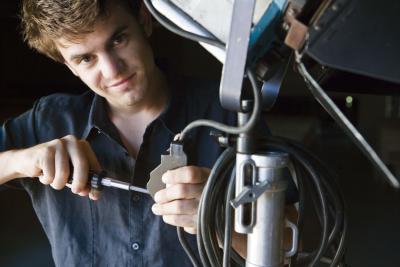
The pinion oil seal is located behind the differential yoke where the rear of the drive shaft is connected. The yoke serves two purposes: to supply a connection point for the drive shaft for transferring power from the engine to the rear and to apply pressure on the pinion bearing holding it in place and preventing backlash in the gears. The drive shaft has universal joints on either end, which create a flexible connection between the transmission and the pinion yoke.
Raise the rear of the vehicle with a floor jack under the rear differential. Place jack stands under the axle tubes and lower the vehicle onto the jack stands. Remove the four nuts on the drive shaft support clamps with a wrench.
Place a screwdriver between the yoke and the universal joint. Pry the drive shaft away from the yoke and lower the drive shaft end to the ground. Remove the large pinion nut in the middle of the yoke with a socket and a ½-inch drive air gun. Hammer the backside of the yoke, pushing it towards the front of the vehicle to remove it.
Insert a large, flat head screwdriver into the opening under the pinion seal around the pinion shaft. Pry out the pinion seal.
Position the new pinion seal into the hole and tap it gently with a hammer around the outside so the seal does not bend to seat it in the housing. Push the yoke back onto the pinion shaft as far as it will go then install the pinion nut.
Tighten the pinion nut just to the point that there is no free-play in the yoke. As soon as free-play is eliminated, stop tightening the nut. This is critical. Position the drive shaft universal joint in the pockets in the yoke, install the C-clamps and tighten them securely. Jack up the vehicle enough to remove the jack stands then lower the vehicle to the ground.